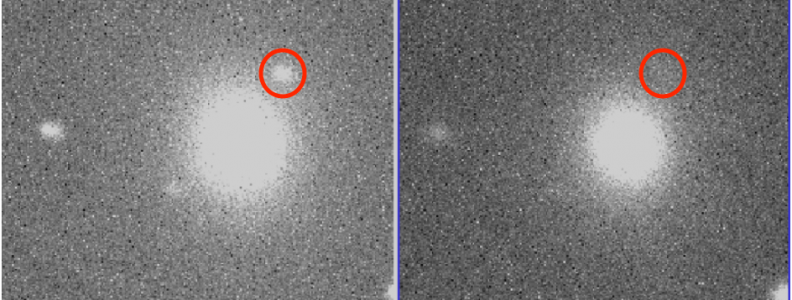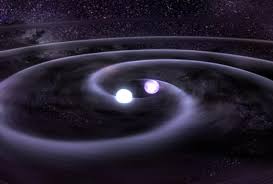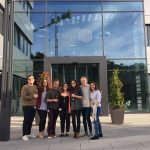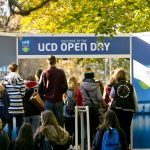Irish Research Council Government of Ireland & UCD Space Science Postgraduate Scholar Lána Salmon writes about a new age of gravitational wave astronomy and her excitement at starting her PhD…
130 million years ago, 2 neutron stars collided near a galaxy called NGC4993. This collision created gravitational waves, which travelled through the universe, reached earth and were detected on August 17th 2017, at the start of my PhD in the UCD Space Science group. A new age of astrophysics was born.
Gravitational waves were first detected in 2015. Einstein predicted, as part of his general theory of relativity, that when heavy bodies such as black holes or neutron stars accelerate, they create a disturbance which stretches space and time and travels at the speed of light. These waves only move space a tiny fraction – a ruler 13km long would only be distorted by the width of an atom. Therefore, the most sensitive detectors ever built are used to detect these waves. These are the LIGO-Virgo interferometers – a team of 3 detectors containing long arms, along which a laser is reflected off mirrors. The gravitational waves affect the length of the arms, therefore distorting the laser signals. Any outside movement, even a car passing by, must be taken into account. We cannot see collisions of black holes as there is no matter to emit light, however it is thought that the collision of neutron stars could be detected by telescopes here on earth. The world has waited for LIGO-Virgo to detect colliding neutron stars so we can begin the search for the light from these collisions.
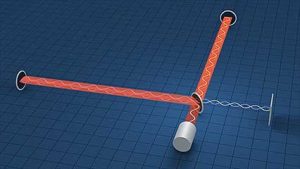
An animation of a LIGO interferometer – Lasers are shone down two perpendicular arms and reflected off mirrors,where they travel back long the arms and meet again.. The detected waves are compared to models for neutron star and black hole mergers.
After my summer internship in the UCD Space Science group, I decided that I would love nothing more than to pursue a career in research. The excitement of delving into data, never before seen by anyone else from state of the art telescopes and satellites, is exhilarating. In August 2016, I met with my supervisors, Professor Lorraine Hanlon and Dr Antonio Martin-Carrillo to discuss potential PhD projects but settled on one that involves continuing the work I began during my internship on Gamma-Ray Bursts, but also pushes the limits to a ground-breaking and exciting topic – Gravitational Wave astrophysics. We applied to the Irish Research Council for funding.
My project aims to search for the visible part of a gravitational wave using UCD’s own Watcher telescope in South Africa. My supervisors warned me of the risks of a project like this – we may never detect the optical counterpart to Gravitational Wave signals. But science is about taking risks, so we proposed the project and after 4 months of waiting, we received the news that I was awarded a Government of Ireland Postgraduate Scholarship to pursue my PhD.
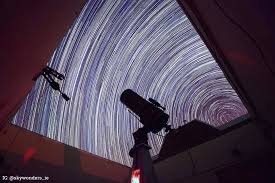
UCD’s Watcher robotic telescope in Boyden Observatory, South Africa. The gorgeous star trails were taken by Dr. Antonio Martin-Carrillo (@skywonders_ie on Instagram)
I was excited and nervous to begin my PhD – I knew there would be a period of a few months to get up to date with Gravitational Wave research so far and to get acclimatised to the research way of life. This quiet acclimatisation was interrupted on the 17th of August, when gravitational waves detected by LIGO Virgo were confirmed to be caused by the merger of neutron stars. Bingo (or Eureka?)! The event we have been waiting for had happened – now all we had to do was search for any visible signs of this gravitational wave event. Telescopes all over the world were searching for this.
A Gamma-Ray Burst was detected by NASAs Fermi telescope around 1 second after the gravitational wave event was detected near galaxy NGC4993. To follow up, the Boyden Telescope located near Watcher in South Africa, pointed towards this event. Over the next few days, we observed this decaying speck of light. My supervisors were working on the data from this telescope. On a Monday afternoon, they called me into a meeting. I had 24 hours to analyse images taken 4 days after the gravitational wave event. Any result that I got from this data would be included in a very influential paper to be submitted to one of the most prestigious scientific journals, Nature. Needless to say, that was a sleepless night. I scoured these images for signs of the optical counterpart to the Gravitational wave and measured the brightness of the event. This measurement was then included in the paper submitted to Nature.
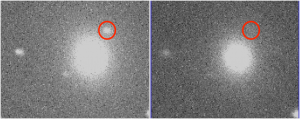
The Gravitational Wave event was detected on August 18th (left) and faded until it is almost unobservable on August 22nd (right).
This paper details the analysis of the light from this event and reveals ground-breaking results. Not only does it suggest that merging neutron stars can create an electromagnetic counterpart which can be detected, but it also sheds light on the processes that occur in a neutron star merger. The detected light can be modelled by a kilonova. When neutron stars merge, the neutrons ejected in the collision undergo radioactive decay, releasing a huge amount of energy. This energy is called a kilonova and is expected to be detectable by telescopes here on earth.
The paper was accepted to be published in Nature on the 16th of October and we were ordered to keep our mouths shut until then. That was easier said than done, when such exciting science was sitting there, ready to be released to the public! In the meantime, the Nobel prize for Physics was awarded to Kip Thorne, Barry Barish and Rainer Weiss for ‘decisive contributions to the LIGO detector and the observation of gravitational waves’. Gravitational wave astrophysics continues to get more and more exciting and I’m feeling very lucky to be starting research in an area which has so many exciting prospects.
Now what? I’m currently writing code for the Watcher telescope to search for these gravitational wave counterparts in the future. I am incredibly excited for the world to see our paper and for future discoveries. The beginning of my PhD has exceeded every expectation. I have always dreamed of being a published scientist – of conducting new and exciting research for the world to see. Every day is exhilarating and I am feeling incredibly lucky to be supported by the Irish Research Council, my amazingly supportive supervisors and UCD.
Links to papers :
https://arxiv.org/abs/1710.05841
http://iopscience.iop.org/article/10.3847/2041-8213/aa91c9
http://www.nature.com/nature/journal/vaap/ncurrent/full/nature24303.html


